Fred Reichheld is the creator of the Net Promoter system of management, the founder of Bain & Company’s Loyalty practice, and the bestselling author of five books. He is currently a Fellow and Senior Advisory Partner at Bain, where he has worked since 1977. Darci Darnell is the global head of Bain’s Customer practice. She has served in multiple global leadership roles, and today sits on the firm’s top elected governance committee. Maureen Burns is a Senior Partner in Bain’s Customer practice. She is one of Bain’s foremost experts on the Net Promoter System and Customer Loyalty.
Below, Fred, Darci, and Maureen share 5 key insights from their new book, Winning on Purpose: The Unbeatable Strategy of Loving Customers. Listen to the audio version—read by Fred, Darci, and Maureen themselves—in the Next Big Idea App.
1. The difference between “NPS” and “nps.”
I have been frustrated that while two-thirds of the large companies in the world have adopted my Net Promoter System, or at least the Net Promoter Score, the vast majority of those companies are misusing it—and some are even abusing it. They’re not achieving even a small fraction of the potential benefit.
Big “NPS” is really the “net purpose score.” It’s the idea that the primary purpose of a business should be to enrich the lives of its customers. The best thing that a leader can do is to inspire their teams to embrace this mission of service to others. Little “nps” is the scoring system to help people measure whether you’re making progress. It’s based on “how likely you’d recommend us to a friend.” Yet so many people are using nps in a way that is antithetical to what NPS stands for: loving customers. When people mis-measure using nps—by doing things like linking it to frontline bonuses, reporting it with no footnotes, or turning it into a vanity metric—it hurts the credibility of the Net Promoter System.
“So many people are using nps in a way that is antithetical to what NPS stands for: loving customers.”
This is not something we can afford to be confused about. If we’re going to build companies that deliver great value and enrich customers’ lives, we’ve got to have a common usage. So rethink whether your nps is oriented around achieving the NPS that I had in mind. I almost called the system “net lives enriched,” because every time you touch a life, you either enrich it or diminish it. And if our purpose is to leave the world a better place, then that is the right thing to measure.
2. Putting customers first, inspiring employees, and living out the principles of Net Promoter will deliver financial performance.
Companies today face a lot of challenges: stakeholder-ism, the great resignation of employees, the way digital amplifies everything we do, and the crisis of disconnection that we’ve experienced over the last two years. Overcoming these challenges requires focusing on enriching customers’ lives as the core of a company’s purpose.
If you start with the aim of enriching customers’ lives, that will fulfill and inspire your employees, and that love spreads into the communities in which we live and work. And ultimately, it will deliver the best financial results that your investors and shareholders are looking for.
Over 10 years ago, we published The Ultimate Question 2.0. As we reflect on the companies in that book and compare them to every major market fund index, they beat it by two to three times. For example, T-Mobile U.S. took a completely different turn when John Legere and his Un-carrier era began. This rewrote the rules of telecom: T-Mobile started listening to customers and employees and acting on their feedback. As a result, their total shareholder return grew by 133 percent over five years, better than Verizon, AT&T, U.S. Cellular, and Sprint, all of their competitors. Its Net Promoter Score went from worst to best in the industry.
“If you start with the aim of enriching customers’ lives, that will fulfill and inspire your employees, and that love spreads into the communities in which we live and work.”
3. A customer-centric purpose creates a virtuous cycle of customer love that actually ends up satisfying employees, investors, and all of your stakeholders.
This is at the core of why we invented Net Promoter in the first place, but a lot of companies have lost sight of it. The fundamentals of the virtuous cycle are simple: purpose at the core, leadership living and breathing the mission, inspiring teams, practicing collective behaviors that promote purpose and empower teams to innovate and improve, being remarkable, creating superior products and experiences that customers truly love. Then you rally and activate your promoters, and help them promote more loudly, effectively, and frequently.
Make sure that you have the foundations of the Net Promoter System in place as the gold standard of continuously listening, learning, and innovating for customers. And if you do all this, customers feel the love. They come back more, they spend more, and they tell their friends. This is the growth you earn, and it has a multiplier effect. You can earn growth faster than you can buy it with sales and marketing.
If you don’t earn your growth, you’ll never be able to build a sustainable, profitable business. Andy Taylor, the longtime CEO of Enterprise Rent-A-Car, once explained his amazing success at growing Enterprise from a tiny niche player into the largest car rental company on earth. He said, “There’s no magic here. You just have to make sure that you treat your customers so that they come back for more—and bring their friends.”
“You can earn growth faster than you can buy it with sales and marketing.”
4. The Earned Growth Rate is a powerful metric.
When it comes to customers coming back for more and bringing their friends, financials today don’t track that. So we introduce a new metric called the Earned Growth Rate, which is essentially the accounting-based twin to Net Promoter Score.
But whereas Net Promoter is soft because it’s based on surveys, Earned Growth is a hard metric. It’s more appropriate for holding people accountable, setting goals, and reporting publicly—with the appropriate footnotes, of course. Earned Growth is simply keeping track of all your growth—how much it is earned by existing customers coming back and buying more, plus the new customers that are coming primarily because of referrals. We have to measure the distinction between that Earned Growth versus bought growth, which is the growth you get via sales, marketing, promotions, and gimmicks.
That idea first came to me at First Republic Bank, where I gave a keynote speech to their executive team a couple years ago. In preparation for my speech, they showed me that over 80 percent of their deposit growth and 90 percent of their loan growth came from existing customers and their referrals. As I dug in, I saw that this was something that we should be measuring universally—not just for banks, but for every kind of business. The new customers who come in on referral are far more profitable; they stay longer, they buy more stuff, and they turn into promoters at a much higher rate than the strangers that you bring in with your sales force, or with advertising and price promotion. For the best companies, Earned Growth is going to be 80, 90, perhaps 95 percent of the total growth rate.
“We have to measure the distinction between that Earned Growth versus bought growth, which is the growth you get via sales, marketing, promotions, and gimmicks.”
5. Customer-centricity and customer love is more important today than it’s ever been.
Many of the companies that are known for customer love today are digital natives—think of Peloton, Warby Parker, or Chewy. As the world becomes more digital, the human connection becomes even more important when customers have complaints, need extra support, or just want to be known and feel loved. Bots can’t bring that empathy and creativity to helping solve your problem.
Let’s take the example of Chewy, and how they are beating Amazon in the category of pet care. Chewy has all of your purchase history—they know what food you buy for your pet, how often you buy them new toys, and what medications are required to keep them healthy. So if you’ve added a medication, they know how severe that is for your pet. And if the medication has run its course and it’s something that is required to keep your pet healthy, they know that the grief has begun. So they reach out, not with a generic email, but with a handwritten letter—either to express their condolences, or to celebrate the fact that your pet is thriving. Nothing makes a pet owner feel more known than when the emotions of your pet’s health and well-being are recognized by the company that you do business with.
To listen to the audio version read by co-authors Fred Reichheld, Darci Darnell, and Maureen Burns, download the Next Big Idea App today:































